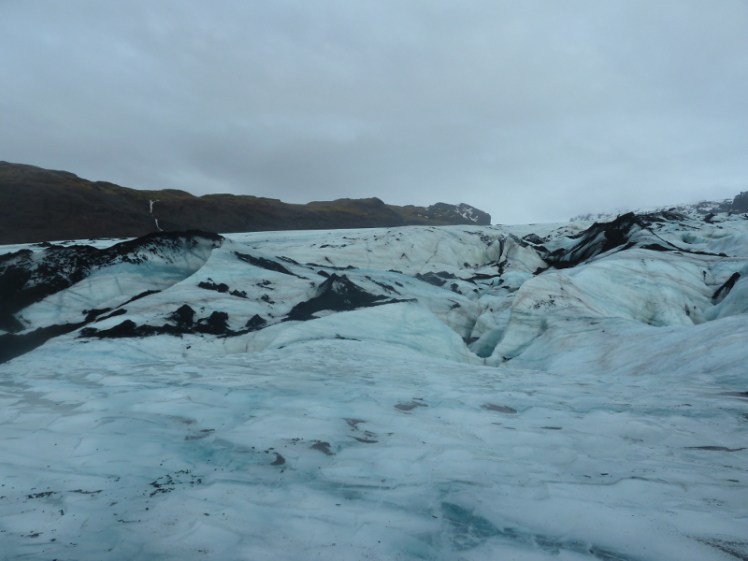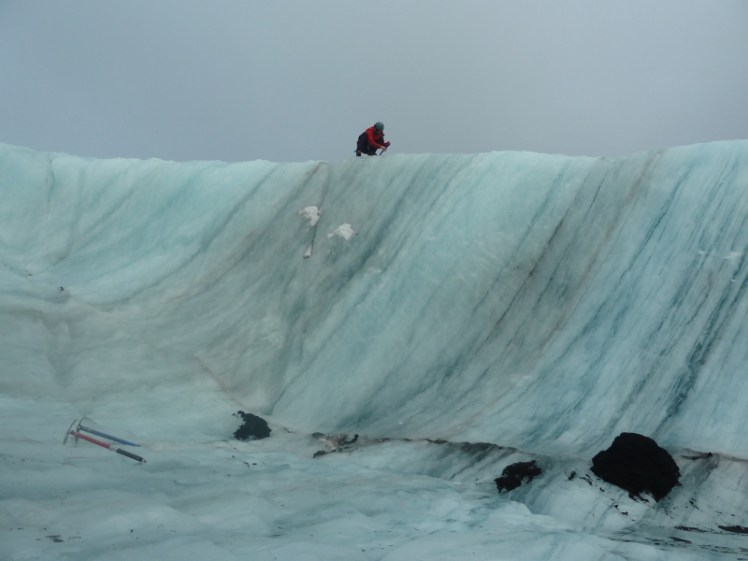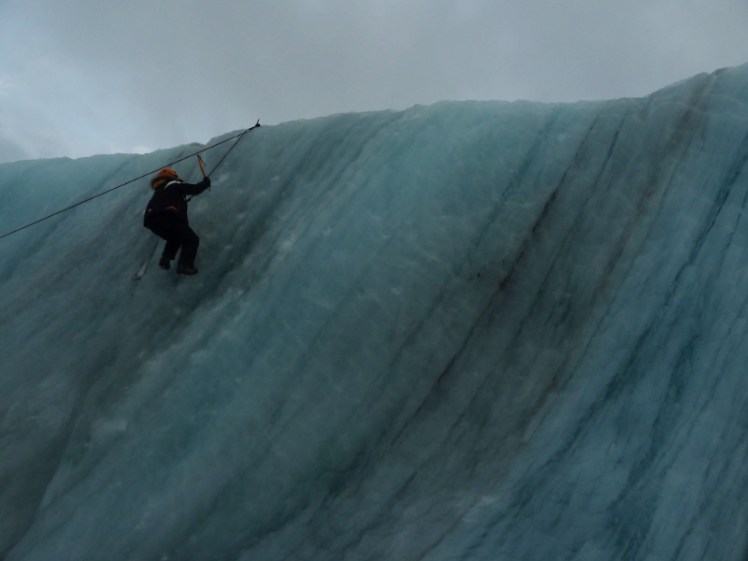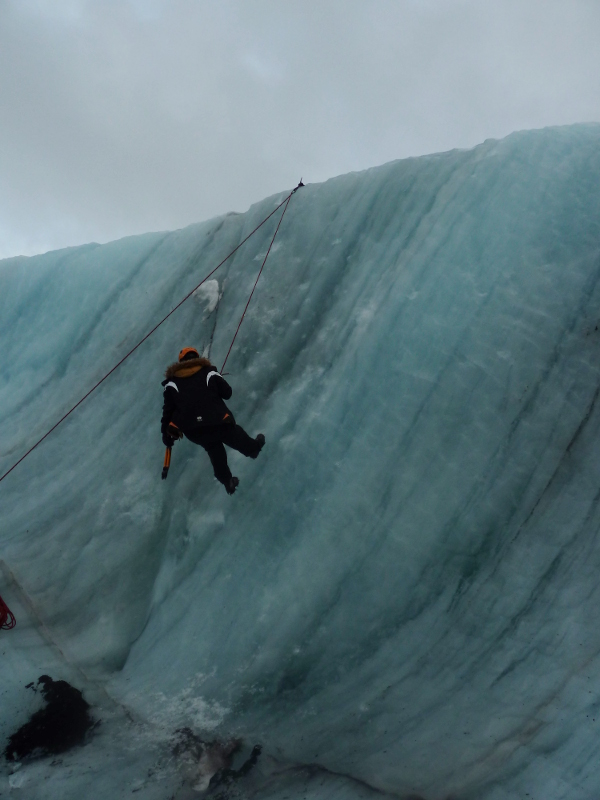Ice-climbing is the most physically demanding thing I’ve ever done. Harder even than extracting myself from the semi-vertical dog-leg squeeze I got wedged in at the bottom of Lionel’s Hole in the Mendips a few years ago.

I was in Iceland, I was in Reykjavik and the bit of ice I was going to climb on was on Sólheimajökull, two hours plus a comfort stop (although I swear they call it something different in Icelandic English) away on the south coast. I had a minibus full of companions, apparently almost exclusively from New York, I had a guide and that guide had crates of helmets, harnesses, crampons and axes. The guide’s name was Dori, because in Iceland, people actually share names with Tolkien characters for real because that’s where he got a lot of his names from – Gandalf, plus five of the dwarves from The Hobbit get their names from three consecutive paragraphs in the Elder Edda.

Crampons are not as complicated as they initially look. Step into them and wrap the strap around following Dori’s precise instructions. And then “tuck the loose end into your sock”, which strikes me as just wrong. This is the most technical piece of kit most of us will ever even touch; surely there’s a better way to deal with the long end than tucking it into your sock? We liked the axes the most – straight ones not quite long enough to be as useful for walking as we were expected to find them. Perfect for posing for beserker photos, though.

Our wall was just ten or twelve feet tall, just a fold in the glacier, the layers pushed into an odd angle as the glacier slid its slow way down the side of the mountain. Dori left us all at the bottom while he hammered in an anchor at the top and then abseiled down, managing a bag, a pair of axes, crampons and both ends of the rope in an impressive way that would have left me a mangled heap in the ice had I tried.

Dori had made it look very easy. Paul from New York made it look a little less easy, and so did the next three people. Two of them lost crampons halfway up and Superman Dori managed to re-tie them while never so much as slackening the belay.

It came to my turn. I’d seen by now that this was not as easy as I’d hoped but I have the blood of a caver, I’d done a reasonable amount of climbing and how much harder could ice be?
A lot harder.
It turns out it has nothing in common with rock climbing other than the harness and the rope.You kick the wall sharply and the two spikes sticking out of the front of your crampons bite in nice and deep. You then stand up on those spikes, swing the climbing axes – smaller than the walking ones, curved and brilliant orange – into the ice above your head and use them to pull yourself upwards before kicking in again a bit higher. It has more in common with SRT, really – Single Rope Technique, a caving thing whereby you scale a rope with your bodyweight in metalwork tied to yourself.
It’s hard for several reasons. For a start, I found it unbelievably counter-intuitive. I admit, I climb caving-style, which is hugely functional and not hugely decorative, largely because it’s done in the dark while wearing wellies and occasionally a wetsuit. I wanted to feel around with my feet for a little knobbly bit I could stand on but even when I found one, the crampons just don’t work like that. You can’t press the side of your foot into the ice and hope it stays put. You can’t wedge your elbow or your shoulder into anything. You definitely can’t use your head as a lever. I knew what I was supposed to be doing it but it felt so wrong.
Second, even by caving standards, I climb badly. I climb using pretty much nothing but upper body strength. Academically, I know I have legs with big muscles that mostly just need to catch on something and straighten but I can’t make that work in practice. I haul myself using my arms. In ice-climbing, the arms are doing little more than providing balance for the legs so that you can climb by simply kicking in one spike after another.
Third, I’m not very good at kicking. I wasn’t getting my toe-spikes in terribly wonderfully but it seems I wasn’t doing so badly, considering the encouraging calls of “good footwork!” from Dori. Or maybe my feet were just good compared to my hands.
The axes. Oh, the axes. Could I get them to bite into the ice? No, I couldn’t! At best, I could catch the tip in there. Maybe it would slip out as I attempted to haul myself up using arm strength. Maybe it would simply shower me in fragments of ice. Maybe I’d hit the ice with the flat rather than the spike. As for the left one, I wasn’t even nicking the ice with it, I was just hammering it, in the flaily sort of way that Mr Tickle would probably climb. Using all my strength to pull myself up, I didn’t have enough to smash the axes into the ice.

Looking at the pictures, it was comical. I know how soon my legs started to tremble from the effort – my feet are barely at Dori’s head height. That’s partly exhaustion, partly adrenaline and partly that my legs aren’t used to taking an active role in climbing. When your arms are flailing uselessly with a dangerous weapon and your legs are trying to do all the work, getting the Elvises is really inconvenient.

I made it to the top. I’m pretty sure that the rope was doing all the work my arms weren’t managing to do; I was being hauled up more than I was actually climbing. In order to reach the top, I had to touch the karabiner with my axe – this I achieved by trying to stand on my toes while said toes were spiked into the ice and shuffling my hand dangerously far down the handle of the axe to make it reach the last inch up. Never has clinking two bits of metal together felt like such a triumph.

I did ok on the abseil – the only person not to need step-by-step instructions on how to come back down. I’d watched three people switch both axes into the same hand and hold them out behind them and the rest, mercifully, was the same as rock climbing, with the notable difference that when I reach ground level, I’d normally put my feet on the ground and bend my knees just enough to give me enough slack in the rope to escape it, whereas this time, my legs didn’t have that left in them and I was lowered right down onto the ice.

I did have to be hauled upright again to untie me and to stagger across the ice to where Tina from New York was looking after my bag and my walking axe but that was it for now. I’d worn waterproof trousers for a reason and I sat there, now trembling all over, drinking the hot chocolate that my lovely landlady had made – with real milk, in a saucepan – several hours earlier.

The last thing to happen was that as we walked down the glacier to the minibus, Dori pointed out the waterfall coming off the mountainside opposite. He said he’d hadn’t seen it this powerful this time of year for a long time. We walked on for another moment before he added “something big is coming” which is actually a really scary thing to hear from a living breathing Tolkien character! Maybe he just meant the real winter weather. Maybe he meant the subglacial eruption from the volcano lurking under our feet, which is ten times the size and power of its more famous neighbour Eyjafjallajökull and is also overdue. Or maybe a great evil is going to descend on Iceland looking for a bit of jewellery.